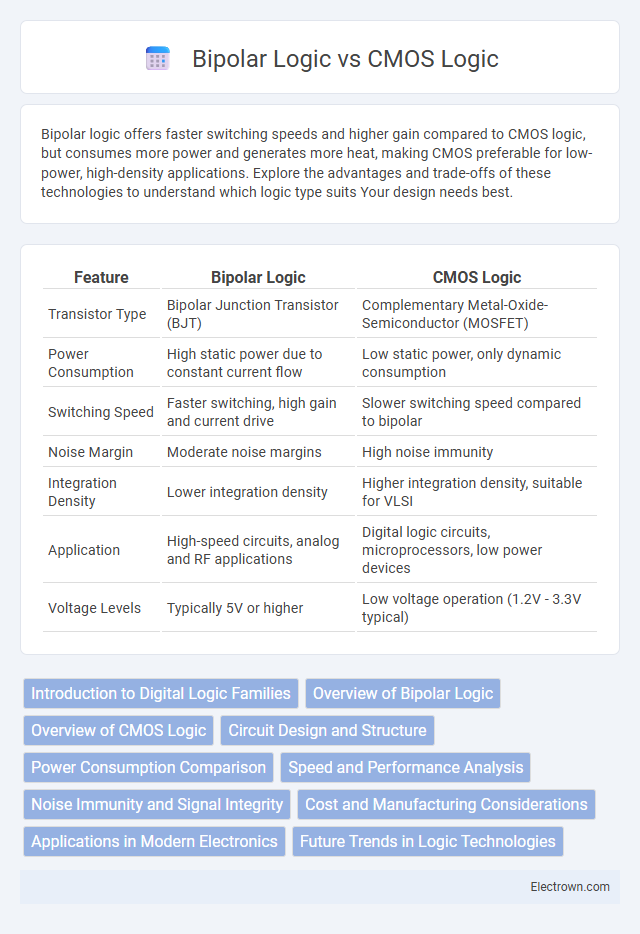Bipolar logic offers faster switching speeds and higher gain compared to CMOS logic, but consumes more power and generates more heat, making CMOS preferable for low-power, high-density applications. Explore the advantages and trade-offs of these technologies to understand which logic type suits Your design needs best.
Table of Comparison
| Feature | Bipolar Logic | CMOS Logic |
|---|---|---|
| Transistor Type | Bipolar Junction Transistor (BJT) | Complementary Metal-Oxide-Semiconductor (MOSFET) |
| Power Consumption | High static power due to constant current flow | Low static power, only dynamic consumption |
| Switching Speed | Faster switching, high gain and current drive | Slower switching speed compared to bipolar |
| Noise Margin | Moderate noise margins | High noise immunity |
| Integration Density | Lower integration density | Higher integration density, suitable for VLSI |
| Application | High-speed circuits, analog and RF applications | Digital logic circuits, microprocessors, low power devices |
| Voltage Levels | Typically 5V or higher | Low voltage operation (1.2V - 3.3V typical) |
Introduction to Digital Logic Families
Bipolar logic and CMOS logic represent two fundamental types of digital logic families used in electronic circuits, each characterized by distinct transistor technologies and switching behaviors. Bipolar logic, often implemented with bipolar junction transistors (BJTs), offers faster switching speeds but higher power consumption, while CMOS logic utilizes complementary MOSFETs to achieve low power dissipation and high noise immunity. Understanding these differences is crucial for selecting the appropriate digital logic family to optimize Your circuit performance and energy efficiency.
Overview of Bipolar Logic
Bipolar logic utilizes bipolar junction transistors (BJTs) which operate by injecting charge carriers, providing high switching speed and strong drive capability suitable for high-frequency applications. This logic family includes technologies like TTL (Transistor-Transistor Logic) known for its robustness and speed, but with higher power consumption compared to CMOS logic. Bipolar logic circuits excel in environments requiring fast response and noise immunity despite their relatively larger power dissipation and heat generation.
Overview of CMOS Logic
CMOS logic, based on complementary pairs of p-type and n-type MOSFETs, offers low power consumption and high noise immunity, making it ideal for modern digital circuits. It achieves near-zero static power dissipation by only drawing significant current during switching, enabling energy-efficient operation in microprocessors and memory devices. CMOS technology supports high-density integration and scalability, contributing to its widespread adoption in VLSI circuit design.
Circuit Design and Structure
Bipolar logic circuits use bipolar junction transistors (BJTs) characterized by higher switching speeds and greater current-driving capabilities, making them suitable for high-frequency applications. CMOS logic employs complementary MOSFETs arranged in pairs to achieve low static power consumption and high noise immunity, enabling dense integration in VLSI designs. Your choice between bipolar and CMOS logic affects circuit complexity, power efficiency, and fabrication costs due to their fundamentally different transistor structures and operation principles.
Power Consumption Comparison
Bipolar logic circuits typically consume more power than CMOS logic due to constant current flow during operation, leading to higher static power dissipation. CMOS logic, characterized by its complementary transistors, significantly reduces power consumption by drawing current only during switching events, making it highly efficient for battery-powered and low-power applications. Understanding these differences helps you optimize circuit design for energy efficiency and thermal management.
Speed and Performance Analysis
Bipolar logic exhibits higher speed and switching performance due to its transistor structure, making it ideal for high-frequency applications, while CMOS logic offers lower power consumption and better integration density. You can achieve faster signal processing in Bipolar circuits because of their reduced propagation delay compared to CMOS. However, CMOS technology excels in power efficiency, which is crucial for battery-operated and large-scale integrated systems.
Noise Immunity and Signal Integrity
Bipolar logic exhibits superior noise immunity due to higher current driving capabilities and faster switching speeds, which enhance signal integrity in high-frequency applications. CMOS logic, while more power-efficient, is more susceptible to noise because of its high input impedance and lower drive currents, potentially causing signal degradation under noisy conditions. Optimizing transistor sizing and layout in CMOS can improve noise margins, but bipolar technology remains preferred for environments demanding robust noise immunity and stable signal integrity.
Cost and Manufacturing Considerations
Bipolar logic circuits typically involve higher manufacturing costs due to complex doping processes and greater power consumption, impacting overall device efficiency. CMOS logic technology benefits from lower production expenses and simpler fabrication techniques, allowing for higher integration density and reduced power usage. Your choice between bipolar and CMOS logic should consider these cost and manufacturing factors to optimize performance and budget constraints.
Applications in Modern Electronics
Bipolar logic, characterized by its high speed and strong drive capabilities, is widely used in high-frequency and analog applications such as RF amplifiers, mixed-signal integrated circuits, and high-speed memory devices. CMOS logic dominates modern electronics due to its low power consumption and high integration density, making it ideal for microprocessors, digital signal processors, mobile devices, and large-scale integrated circuits. Emerging technologies often combine bipolar and CMOS transistors in BiCMOS technology to leverage the speed of bipolar and the power efficiency of CMOS for applications in communications and automotive electronics.
Future Trends in Logic Technologies
Future trends in logic technologies emphasize the integration of bipolar logic's high-speed switching capabilities with CMOS logic's low power consumption to achieve optimal performance in advanced circuits. Innovations like BiCMOS technology combine bipolar transistors and CMOS transistors on a single chip, enhancing speed and energy efficiency in modern microprocessors and communication devices. Research continues to focus on scaling these hybrid technologies for next-generation applications, including AI accelerators and high-frequency wireless systems.
Bipolar logic vs CMOS logic Infographic

 electrown.com
electrown.com